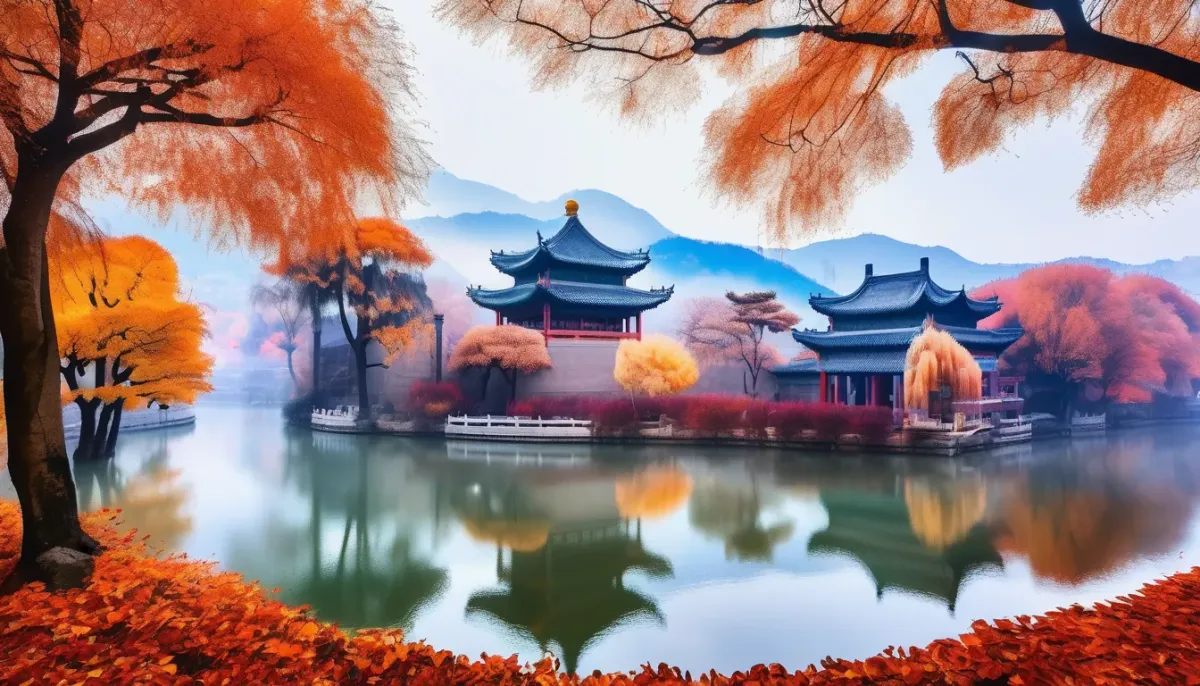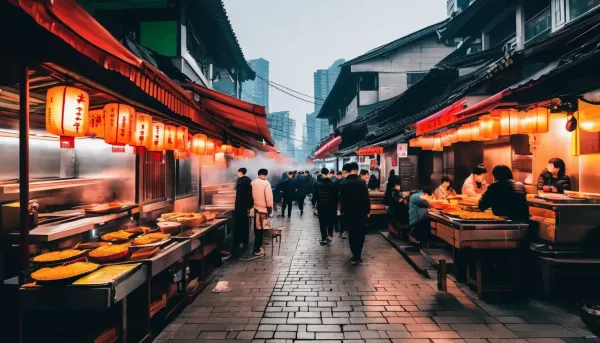Tourist Guide to China in Late Autumn to Winter
Discover China in late autumn to winter, from Harbin's dazzling Ice Festival to Beijing's iconic Great Wall, where fewer crowds await. Explore Xi'an's Terracotta Warriors, savor Chengdu's spicy cuisine, and unwind in tropical Sanya.

Visiting China during late autumn to winter offers a unique blend of cultural experiences, stunning landscapes, and seasonal festivities. While the temperatures drop, the charm of this vast country remains vibrant, with destinations offering everything from snow-covered cities to warm coastal retreats. This guide will take you through some of the best places to visit, activities to engage in, and essential travel tips for an unforgettable experience.
1. Harbin: The Ice City
Overview
Harbin, located in northeastern China, is famous for its harsh winters and the spectacular Harbin International Ice and Snow Sculpture Festival. Each year, artists from around the world gather to create massive ice sculptures, illuminating the city with stunning displays.
What to Do
- Ice and Snow Festival: The festival usually starts in early January. Make sure to check dates and plan your visit accordingly. You’ll find ice castles, slides, and sculptures that are nothing short of mesmerizing.
- Central Street (Zhongyang Dajie): This historical pedestrian street is lined with European-style architecture. Enjoy the festive lights and warm up with local snacks like roasted chestnuts and sweet potato.
- St. Sophia Cathedral: A beautiful Russian Orthodox church that offers a glimpse into Harbin’s past as a hub for Russian immigrants.
- Siberian Tiger Park: Home to over 800 Siberian tigers, this park offers an incredible opportunity to see these majestic animals up close.
Tips
- Dress warmly! Temperatures can drop below freezing, so layers, thermal wear, and insulated boots are essential.
- Try the local specialty, Harbin beer, and enjoy a hot pot meal to warm up after a day in the cold.
2. Beijing: The Heart of China
Overview
As the capital city, Beijing is steeped in history and culture. Winter offers a quieter experience at major attractions, allowing you to explore the city's rich heritage without the summer crowds.
What to Do
- The Great Wall: Visiting during winter means fewer tourists. The wall at Mutianyu is a great choice, with breathtaking views and a cable car option to avoid the steep hike.
- Forbidden City: The imperial palace looks stunning in the winter light. Be sure to check for any seasonal exhibitions that might be taking place.
- Temple of Heaven: A UNESCO World Heritage site, this temple is not only architecturally significant but also a great place to see locals practicing tai chi in the crisp morning air.
- Winter Festivals: Experience the Lantern Festival in February, which features beautiful lantern displays and cultural performances.
Tips
- Use the subway to navigate the city efficiently. It’s inexpensive and convenient.
- Enjoy a Peking duck dinner at a reputable restaurant like Quanjude for an authentic culinary experience.
3. Xi'an: The Ancient Capital
Overview
Xi'an is known for its rich history, most famously as the starting point of the Silk Road and home to the Terracotta Army. The winter months allow you to explore this ancient city with fewer crowds.
What to Do
- Terracotta Warriors: This archaeological wonder is a must-see. Winter visits offer a chance to explore without the long lines typical in warmer months.
- Xi'an City Wall: Rent a bicycle and ride along the ancient city wall, which offers beautiful views of the cityscape, especially at sunrise.
- Muslim Quarter: Explore this vibrant area for its unique food stalls, where you can try local specialties like roujiamo (Chinese hamburger) and yangrou paomo (bread in mutton soup).
Tips
- Book tickets to the Terracotta Army in advance to skip the lines.
- Sample street food but be cautious about hygiene—choose busy stalls for fresher options.
4. Lijiang: A Scenic Escape
Overview
Lijiang is known for its picturesque landscapes, ancient architecture, and the rich culture of the Naxi people. Winter in Lijiang offers a peaceful retreat with stunning views of snow-capped mountains.
What to Do
- Old Town of Lijiang: A UNESCO World Heritage site filled with narrow cobbled streets, traditional wooden houses, and vibrant markets. Explore local artisan shops and cafes.
- Jade Dragon Snow Mountain: A stunning mountain range perfect for hiking or taking a cable car to enjoy panoramic views.
- Black Dragon Pool Park: A beautiful park with picturesque views of the mountains and reflections in the water, ideal for photography.
Tips
- Winter temperatures can vary, so layer your clothing.
- Consider visiting local tea houses to experience traditional Naxi tea culture.
5. Chengdu: The Panda Capital
Overview
Chengdu, the capital of Sichuan Province, is famous for its spicy cuisine and giant pandas. Winter is a great time to visit as the city is less crowded and the pandas are particularly active.
What to Do
- Chengdu Research Base of Giant Panda Breeding: Visit early in the morning when the pandas are most active. The facility is committed to conservation and provides educational exhibits.
- Jinli Ancient Street: A vibrant area filled with shops, restaurants, and street performances. Try local snacks like dandan noodles and mapo tofu.
- Sichuan Opera: Experience the unique art of face-changing (Bian Lian) in a traditional performance. Look for venues that offer dinner and a show.
Tips
- Use public transport or taxis to navigate the city easily.
- Be prepared for spicy food; ask for less spice if you’re not used to it!
6. Guilin and Yangshuo: Nature’s Paradise
Overview
Guilin and Yangshuo are known for their dramatic karst landscapes and the beautiful Li River. Winter offers a serene experience with mist-covered mountains.
What to Do
- Li River Cruise: A scenic boat ride from Guilin to Yangshuo offers breathtaking views of the karst peaks. Winter mist adds a mystical quality to the landscape.
- Yangshuo Countryside: Rent a bicycle or take a bamboo raft to explore the rural scenery. The landscapes are stunning in winter, and it’s less crowded.
- Impression Liu Sanjie: A spectacular outdoor show set against the backdrop of the mountains, showcasing local culture through music and dance.
Tips
- Dress in layers; it can be cool in the mornings and evenings.
- Try local rice noodles (Guilin mifen) and beer fish for an authentic meal.
7. Sanya: Tropical Retreat
Overview
For those seeking warmer weather, Sanya on Hainan Island is China’s tropical paradise. It boasts beautiful beaches, luxury resorts, and a laid-back atmosphere.
What to Do
- Yalong Bay: Known for its white sandy beaches and clear waters, it’s perfect for sunbathing and water sports.
- Nanshan Temple: A large Buddhist temple complex featuring a towering statue of Guanyin. The serene environment is perfect for relaxation and reflection.
- Sanya Bay: Enjoy stunning sunsets and beachside dining in this picturesque area.
Tips
- Sanya is more relaxed, so embrace the slower pace.
- Book accommodations in advance, especially if traveling during peak holiday periods.
8. Hangzhou: The City of Silk
Overview
Famous for its picturesque West Lake, Hangzhou is a city steeped in history and natural beauty. Winter adds a tranquil atmosphere, making it a great time to visit.
What to Do
- West Lake: Take a leisurely stroll or a boat ride on the lake. The winter scenery, with mist rising off the water, is stunning.
- Lingyin Temple: One of the largest and most important Buddhist temples in China. It’s a peaceful place to explore, with beautiful carvings and serene surroundings.
- Tea Plantations: Visit the Longjing tea fields to learn about tea production and sample some of the finest green tea in China.
Tips
- Dress warmly for outdoor activities around the lake.
- Don’t miss trying the local cuisine, especially dishes featuring Longjing tea.
Travel Tips for Winter in China
1. Dress Appropriately
Winter in China can be cold, especially in northern cities. Layering is key, as temperatures can vary throughout the day. Ensure you have a warm coat, gloves, hats, and thermal wear.
2. Book in Advance
Whether it's flights, train tickets, or accommodations, booking in advance is crucial, especially around Chinese holidays like the New Year.
3. Be Mindful of Holidays
Chinese New Year (usually late January to mid-February) can significantly affect travel plans, as many locals travel home during this time. Attractions may be crowded, and prices can soar.
4. Embrace Local Cuisine
Winter is a great time to indulge in hearty local dishes. Don’t miss out on hot pot, dumplings, and seasonal specialties.
5. Learn Basic Mandarin Phrases
While many tourist areas have English signage, knowing basic phrases can enhance your experience and help in less touristy areas.
Conclusion
Exploring China in late autumn to winter offers a diverse range of experiences, from vibrant cultural festivals to breathtaking natural landscapes. Whether you’re visiting the icy sculptures of Harbin or the serene waters of West Lake, each destination presents its unique charm. Embrace the rich history, indulge in delicious cuisine, and immerse yourself in the local culture for an unforgettable journey. With careful planning and an adventurous spirit, your winter trip to China will surely be memorable.



